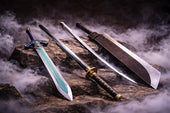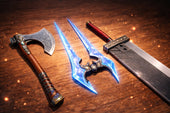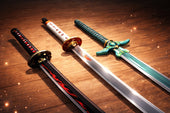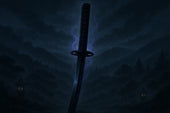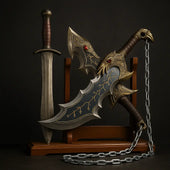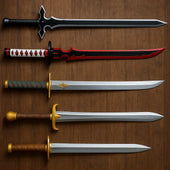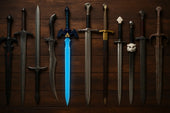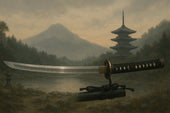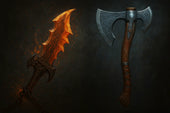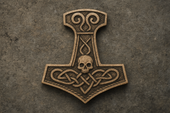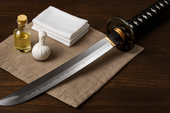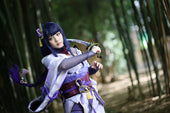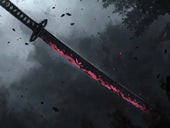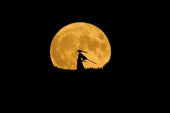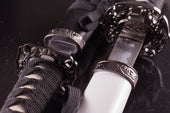The katana and longsword are two of the most iconic weapons in history, each with its own unique legacy and cultural significance! While both swords have captured the imagination of martial artists and enthusiasts alike, they differ vastly in design, purpose, and fighting style. Did you know that the katana is renowned for its curved blade and quick drawing techniques, while the longsword is celebrated for its versatility and reach? In this article, we’ll delve into the key differences between these legendary swords, exploring their history, design, and combat techniques. Let’s embark on this journey to uncover what makes each weapon special!
1. Historical Background
The Katana
The katana, a symbol of Japanese culture, has a rich history that dates back to the Kamakura period (1185–1333). Initially, Japanese swords were straight and double-edged, but as combat techniques evolved, so did the design of the sword. The katana emerged as a response to the need for a weapon that could be drawn quickly and used effectively in close combat. Its curved blade allowed for swift, slicing attacks, making it ideal for the fast-paced battles of the time.
The katana became deeply entwined with the samurai class, representing honor, bravery, and the warrior's way of life (bushido). The sword was not just a weapon; it was an extension of the samurai’s spirit and a reflection of their status. As the centuries progressed, the katana's craftsmanship evolved, with skilled swordsmiths honing their techniques to create blades of unparalleled quality.
The Longsword
In contrast, the longsword has its roots in medieval Europe, emerging during the late 14th century. This sword was designed for a different type of combat, suitable for both slashing and thrusting. The longsword’s design allowed for effective use in armored combat, making it popular among knights and foot soldiers alike.
The longsword is often associated with chivalric ideals and the code of conduct that governed knights. Its use in tournaments and duels became prevalent, highlighting the importance of skill and honor in combat. Over time, various styles of longswords emerged, each tailored to different fighting techniques and martial traditions, leading to the rich history of European swordsmanship we recognise today.
2. Design and Construction
Katana Design Features
The katana is characterised by its distinct features that contribute to its performance and aesthetic appeal:
- Curvature: The blade's curve enhances slicing capabilities, allowing for smooth and efficient cuts.
- Single Edge: The katana typically has a single sharpened edge, which simplifies the sharpening process and enhances cutting efficiency.
- Length: Katanas generally measure between 23 to 28 inches (58 to 71 cm), making them ideal for quick, close-quarters combat.
The construction of a katana involves meticulous craftsmanship, often incorporating high-carbon steel for strength and flexibility. The process of forging a katana can take weeks or even months, with skilled swordsmiths folding the steel to eliminate impurities and create a resilient blade.
Longsword Characteristics
The longsword showcases its own unique design elements that reflect its use and versatility:
- Straight Blade: The straight, double-edged blade allows for both slicing and thrusting, making it effective in various combat scenarios.
- Length: Longswords typically range from 30 to 42 inches (76 to 107 cm), providing a greater reach in battle.
- Cross-Guard: The cross-guard protects the wielder’s hands and facilitates leverage during combat.
Longswords are crafted from a variety of steels, with the blade designed to withstand the rigors of battle. The balance and weight of the sword are carefully considered to enhance the user’s control and maneuverability.
3. Combat Techniques and Styles
Katana Fighting Techniques
The techniques associated with the katana are deeply rooted in Japanese martial arts:
- Kendo: A modern sport that emphasises discipline, precision, and respect. Practitioners use bamboo swords (shinai) to develop skills that translate to the katana.
- Iaido: Focused on the art of drawing the sword and quickly executing a cut. This practice emphasises smooth, controlled movements and mental focus.
Katana techniques prioritise quick draws and slicing strikes, often employing tactics that rely on speed and agility. The curvature of the blade enhances the effectiveness of these movements, allowing for fluid attacks in close combat.
Longsword Fighting Techniques
Longsword techniques are characterised by their versatility and strategic approach:
- Half-Swording: A technique where the wielder grips the blade with one hand to gain better control and leverage for thrusting.
- Various Guards and Stances: Different positions allow for offensive and defensive maneuvers, making the longsword adaptable to various fighting situations.
Combat with a longsword emphasises strategy and footwork, as fighters need to maintain distance and leverage their reach. Techniques often involve a combination of strikes, thrusts, and grappling, allowing for a well-rounded approach to combat.
4. Cultural Significance
The Katana in Japanese Culture
The katana holds immense cultural significance in Japan, symbolising the samurai's honor, discipline, and the warrior ethos. It is often regarded as a sacred object, with the forging process considered a spiritual journey for the swordsmith. The katana is not merely a weapon; it represents the ideals of bushido, including loyalty, bravery, and self-discipline.
In addition to its martial significance, the katana has become a symbol of Japanese identity, appearing in various art forms, literature, and popular culture. Its representation often evokes themes of honor and sacrifice, reflecting the deep respect for the sword in Japanese society.
The Longsword in European History
The longsword is equally significant in European history, embodying the ideals of chivalry and knighthood. It symbolises the warrior's honor and the code of conduct that governed knights during the medieval period. The longsword was not only a weapon but also a status symbol, often adorned with intricate designs that reflected the owner’s wealth and prestige.
In modern times, the longsword has been romanticised in literature and media, often portrayed as the weapon of choice for noble heroes. Its historical significance continues to influence martial arts and combat sports, ensuring its legacy endures in contemporary society.
5. Performance and Practicality
Advantages of the Katana
The katana excels in speed and agility, making it highly effective in quick, close-quarters encounters. Its design allows for swift cuts and easy maneuverability, enabling the wielder to execute rapid strikes against opponents. The katana's sharpness and curvature enhance its cutting ability, making it particularly adept at slicing through targets.
However, its shorter length may limit its effectiveness in long-range combat or against heavily armored opponents, where a longer weapon might offer an advantage.
Versatility of the Longsword
The longsword is celebrated for its versatility and range, making it suitable for various combat scenarios. Its longer blade allows for powerful thrusting attacks, while its double-edged design enables effective slicing motions. The longsword’s adaptability means it can be used in different fighting styles, accommodating both offensive and defensive maneuvers.
The weight and balance of the longsword provide stability and control, making it effective for both one-on-one duels and larger battlefield engagements. This versatility has contributed to its enduring popularity in historical reenactments and martial arts practices.
6. Modern Interpretation and Popular Culture
Katanas in Movies and Media
The katana has become a staple in movies, anime, and video games, often portrayed as a mystical weapon wielded by skilled warriors. Films like Kill Bill and anime such as Samurai Champloo have contributed to its romanticised image, depicting the katana as a symbol of honor and deadly efficiency. These portrayals have helped solidify the katana's status as an iconic weapon in popular culture.
Longswords in Movies and Media
Longswords also feature prominently in film and literature, often associated with knights and epic battles. Swords from The Lord of the Rings and shows such as Game of Thrones showcase the longsword as a weapon of choice for heroes and villains alike, contributing to its legacy as a symbol of valor and chivalry.
These portrayals often emphasise the historical significance of the longsword, showcasing its adaptability and importance in medieval warfare.
Conclusion
Both the katana and longsword hold a revered place in the history of weaponry, each reflecting the values and techniques of their respective cultures! By understanding their differences and similarities, we can appreciate the craftsmanship and legacy of these iconic swords. Whether you admire the katana for its elegance and quick-draw techniques or the longsword for its versatility and historical significance, both weapons offer a fascinating glimpse into martial tradition. Ready to dive deeper into the world of swords? Let’s continue exploring their rich history and enduring legacy!




